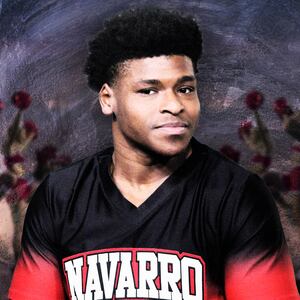Few reality-TV stars have captured our attention in such a pure, affectionate way as the cast of Netflix’s Cheer. Soon after its premiere in January of 2020, the members of Navarro College’s elite cheerleading team went from small-town heroes to household names with huge social media followings—well, some of them. The docuseries’ main cast members embarked on an extensive press tour, appearing on Ellen, The Late Show with Stephen Colbert and the Oscars red carpet (and in parody form on Saturday Night Live), and meeting high-profile fans like Kendall Jenner, Laura Dern, and J.J. Watt. By the time Cheer and its executive producer and director Greg Whiteley were nominated (and later won) several Emmys, it seemed like the least of the series’ accomplishments.
By the end of 2020, however, Cheer’s presence in the zeitgeist had taken a dark turn. In September, Jerry Harris, arguably the show’s most beloved cast member known for his high-pitched “mat talks,” was arrested and charged with child pornography and the sexual exploitation of children after allegedly soliciting sexually explicit photos from minors; he is currently behind bars awaiting trial. The following February, a second cheerleader, Mitchell Ryan, and cheer coach and choreographer Robert Joseph Scianna Jr., who both appeared in the series, were charged with aggravated sexual assault of a child and taking indecent liberties with a child, respectively. A grand jury declined to indict Ryan, while Scianna Jr. pleaded guilty and is awaiting sentencing.
Season 2 of Cheer, premiering today, tackles Harris’ alleged misdeeds in an unflinching manner with interviews from two of his victims and reactions from his former teammates. And yet, this horrifying incident is far from the only obstacle we watch Navarro navigate this season, from pandemic cancellations to winter power outages to Dancing With the Stars. While season 1 depicted the elite cheer squad as a sort of scrappy but high-performing machine, its second season reveals how quickly these sort of structures can fall apart.
The season begins by exploring the newfound fame several (but not all of) Navarro’s cheerleaders experienced following the release of the show. We watch footage of Gabi Butler, Morgan Simianer, Lexi Brumback, La’Darius Marshall and their head coach Monica Aldama at the aforementioned press stops, selling products on Instagram and discussing other business opportunities. While the divide between the show’s stars and the other cheerleaders breeds some tension, the series and its principal cast still feel relatively grounded. It helps that the series takes place in a small, insular world and revolves around a specific goal—a first-place trophy at the NCA National Championships in Daytona—requiring the time and commitment of each of its stars. Rather than watching these young people spend their sponcon checks and move into luxury apartments, they’re filming $50 Cameos inside their tiny dorm rooms and discussing their plans to start YouTube channels before they head to practice the next morning.
Whiteley makes the bold choice to split their screen time, not only with a new class of Navarro cheerleaders but their Daytona rivals at Trinity Valley Community College, who we were briefly introduced to last season. Viewers on social media who noticed the series’ lack of Black women as opposed to men will be pleased to meet Jada Wooten, a self-designated captain amongst the team and, later on, superstar tumbler Angel Rice. The noticeably more diverse Trinity Valley is cast as a second-tier cheering program compared to Navarro—although they once had a better reputation than them. Coached by the even-keeled Vontae Johnson, their team lacks the flashy choreography and personality crucial to Navarro's winning formula. There also aren’t as many standout characters compared to Navarro’s TV-ready cheerleaders, despite how dramatically Whiteley tries to capture their personal narratives and group interactions. While there's some joy in watching their growth by the end of the season, we understand why these athletes weren’t the original stars of the show.
As we watch Trinity Valley find their mojo, Navarro faces a series of setbacks, from Harris’ arrest, the pandemic and, on a much lighter note, Aldama’s time competing on Dancing With the Stars. Oddly enough, Aldama’s two-month break from coaching to compete on her favorite television show is ultimately more devastating to the team’s chemistry, the rookies’ experience, and her relationship with one of the veteran cheerleaders.
Viewers who were turned off by Aldama’s unethical style of coaching framed throughout the series, and praised by many fans as a tough-mother act, will be relieved to see her portrayed in a much harsher light this season (before giving her a sympathy edit). Aside from cast members reacting negatively to her absence, we see the criticism Aldama received on social media for her delayed, concise response to Harris’ arrest in the fifth episode. Although she tends to speak in a terse manner, her reaction to his misconduct in her interview won’t do much to quell accusations that she’s indifferent to his behavior. For a moment, viewers can empathize with the coach as she recounts her physical and emotional reaction to reading such an upsetting headline about someone she viewed as her child. But she doesn’t have anything to say beyond general expressions of shock and that she has “conflicting emotions.” As the episode goes on and we learn more about cheer organizations’ systematic indifference to accusations of sexual assault, her response becomes more infuriating, as we realize people, who may not condone these things but are hesitant to speak explicitly about them, are a part of the problem.

Despite Aldama’s unwillingness to speak at length about Harris, Whiteley, along with Chelsea Yarnell, who co-directs the fifth episode, do their due diligence by giving screen time to twins Charlie and Sam, who were 13 when they claim Harris preyed on them, as well as journalists who did extensive reporting on Harris and an attorney who’s also an advocate for sexual-assault survivors. Hearing their testimonies as well as their mother’s is deeply upsetting and earns the episode’s trigger warning. Whiteley largely leans on the side of the victims, only interviewing cast members who believe he committed misconduct. It’s a relief that the series doesn’t entertain the narrative that Harris’ inspiring public persona complicates these accusations. Instead, we’re shown footage throughout the episode of Harris being fawned over by the public, illustrating how much power he had within the cheer community and how easily it could be abused.
Cheer’s second season is a tougher binge than the first time around, and not just in its thematic content. While Whiteley tries to recreate season one’s pathos by exploring new characters and their humble beginnings, these backstories aren’t always compelling or necessarily worth telling in a dramatic way. Toward the middle of the nine-episode season, the sheer number of cast members and competing story arcs becomes overwhelming. There are also side segments relaying uninteresting facts about the cheer world that feel like filler, including a very delayed sequence about the girls wearing their hair in “poofs.” Additionally, the amount of practice footage we see of full routines undermines the excitement of watching the teams perform at Daytona.
Overall, Cheer is still a fascinating piece of television that feels refreshingly honest in its storytelling. The confidence with which Whiteley and Yarnell tackle this season’s conflicts, whether or not it’s fun to watch, prove that this series is in great hands. Cheer may not be as instantly comforting as it was in its inaugural season, but few shows depicting real life over the past two years have been.







